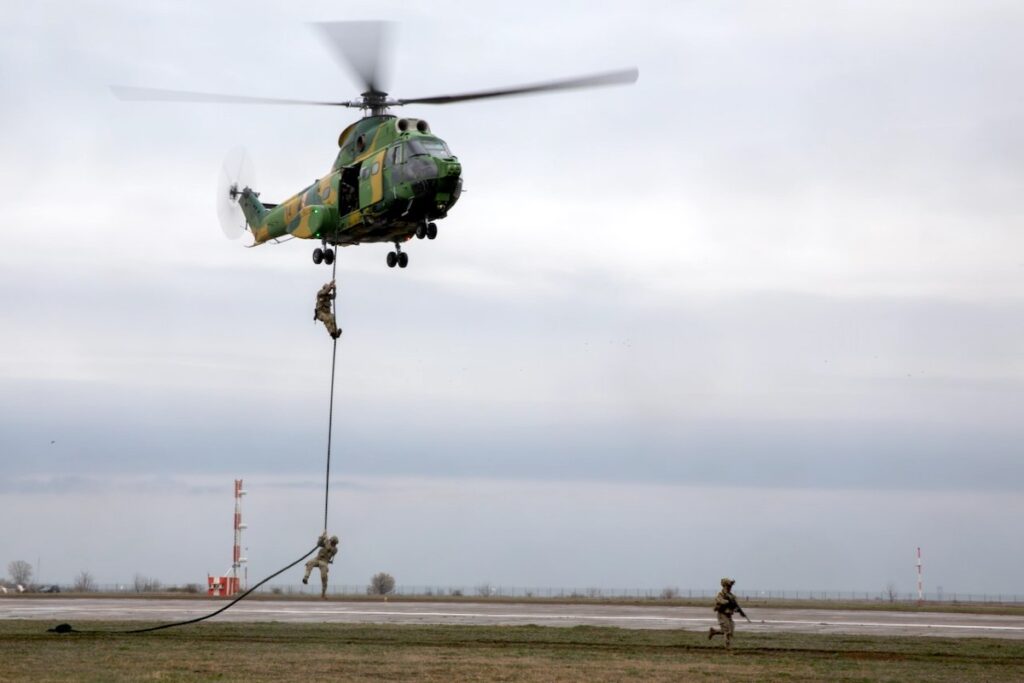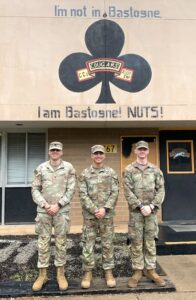
The latest deployment of soldiers from Fort Campbell recently arrived in Romania, placing them at one of the nearest possible outposts to the war in Ukraine.
They’re part of a heightened U.S. presence in Europe that’s meant to assure allies.
For many of the soldiers, like Spc. Sean Leonnig, it’s a first deployment. He was among a few dozen soldiers with the 101st Airborne 1st Infantry Brigade Combat Team waiting to fly out on a recent chilly morning.
A dog trotted between the camo-clad soldiers, getting some last-minute petting. Everyone else had already said their goodbyes.
“I officially said goodbye as of 8:30 this morning,” Leonnig said.
Back home: his wife and 9-month-old son.
How often will he keep in touch?
“As long as I have internet, as much as I can,” he said.
He’s part of a brigade of about 4,000 soldiers who have made their way to the Mihail Kogălniceanu Air Base in Romania.
“We are the soldiers that everyone imagines, with the ruck on their back, moving along miles, a rifle in hand,” said 1st Lt. Jonathan Clymer. He is a former electrical engineer who now leads an infantry platoon.
In response to Russia’s invasion, the US raised its troop count in Europe last year by about 20,000. The 101st’s 1st Unit is part of that increase.
Their mission: assure allies and deter Russian aggression on NATO’s eastern flank.
“I have lots of confidence in my soldiers as well as in my superiors that if anything were to happen we are as prepared as we’ll ever be for that fight,” said Clymer.
Day to day in Romania, a lot of what the brigade is doing is training with other militaries.
They simulate scenarios and plan how to respond. In the field they have live fire drills in which soldiers use weapons and equipment from different countries.
 Katherine Ceicys WPLN News
Katherine Ceicys WPLN NewsFrom left, Spc. Sean Leonnig, 1st Lt. Jonathan Clymer, and Cpl. Matthew Gatton are among those who recently deployed to Romania, near Ukraine, with the 101st Airborne Division.
Teamwork with foreign soldiers is a draw for first-timers like Cpl. Matthew Gatton. He joined the army for college and then reenlisted to see more of the country and the world.
“I like working with people from all over the world. It’s a good eye opener,” he said.
Col. Kevin Sharp commands the brigade. He’s been on the ground in the unseasonably cold Romania for about five weeks.
He said a key part of the joint training exercises is testing communications.
“What I’m looking for is, hey, can our communication systems operate effectively and can we talk to each other at each critical juncture and throughout the chain of command?”
His soldiers expect to be deployed for about 9 months.
There hasn’t been any official word yet if the US will maintain the increased troop levels. That likely depends on what happens with Russia in Ukraine.
Lithuania is hosting the next NATO summit in July where leaders are expected to discuss NATO’s support of Ukraine and strategy towards Russia.
The soldiers are aware of — and sensitive to — the close conflict.
“There is definitely, I wouldn’t say a tension, but I would say an increased sense of urgency to develop training readiness,” Sharp said. “Really, readiness across the entire spectrum.”
For the soldiers of the 101st’s 1st Unit, as long as things stay calm, their presence will be enough to fulfill their mission.

